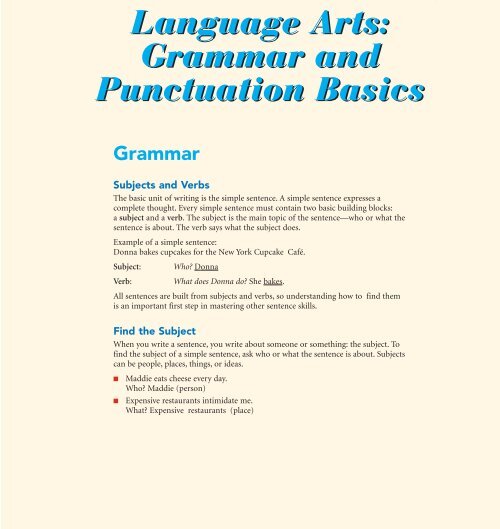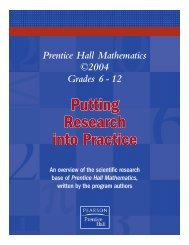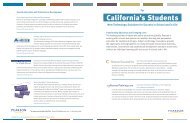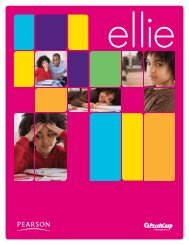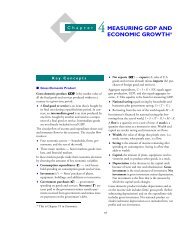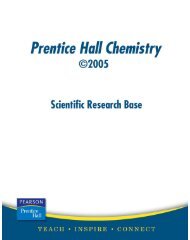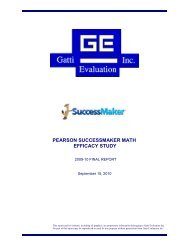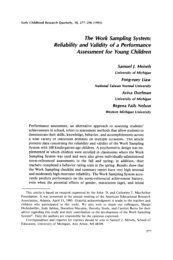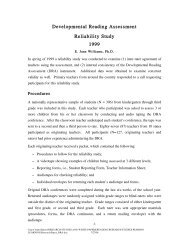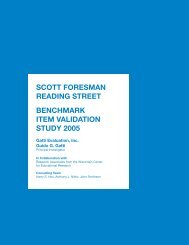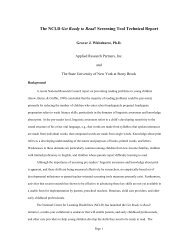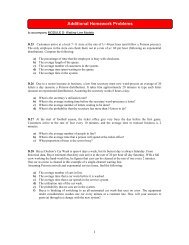Language Arts: Grammar and Punctuation Basics ... - Pearson
Language Arts: Grammar and Punctuation Basics ... - Pearson
Language Arts: Grammar and Punctuation Basics ... - Pearson
Create successful ePaper yourself
Turn your PDF publications into a flip-book with our unique Google optimized e-Paper software.
The subject never appears within a prepositional phrase, so you should ignore prepositional phrases when looking for thesubject of a sentence. In the examples below, the prepositional phrases are crossed out.■ Through the night, we heard a strange tapping sound.Subject:Who? WeVerb:What did we do? We heard.■ The music at the party was boring.Subject:What? The musicVerb:What about the music? It was.Helping Verbs <strong>and</strong> Verb PhrasesBoth action <strong>and</strong> linking verbs often are accompanied by other special verbs called helping verbs. Helping verbs frequentlyshow time. Listed below are some frequently used helping verbs.Helping Verbscan Might shouldcould Must used tohave need willmay shallMain verbs accompanied by one or more helping verbs are called verb phrases. For example, following are some verbphrases formed by adding helping verbs to the main verb learn:Helping Verbs <strong>and</strong> Verb Phrasesis learning has learned should have learnedwas learning will learn should have been learnedhad been learning had learnedhas been learned should have been learningBelow are sentences that contain verb phrases:■■Eliza will be moving to Washington next week.Subject:Who? ElizaVerb phrase:What about her? She will be moving.We should have left hours ago.Subject:Who? WeVerb phrase:What about us? We should have left.
FragmentsA word group that lacks a subject or a verb <strong>and</strong> that does not show a complete thought is called a fragment. Because fragmentsare incomplete thoughts punctuated as complete ones, they can confuse readers <strong>and</strong> must be avoided. One key toeliminating fragments from your writing is knowing the difference between two types of word-groups: phrases <strong>and</strong> clauses.Phrases <strong>and</strong> ClausesA group of words without a subject/verb unit is called a phrase. A group of words with a subject/verb unit is calleda clause.■■Phrase (Fragment):My relatives in Chicago. (no verb)Clause:My relatives live in Chicago. (contains a subject, relatives, <strong>and</strong> a verb, live)Phrase (Fragment):Rounding the corner. (no subject)Clause:A red convertible was rounding the corner.(contains a subject, convertible, <strong>and</strong> a complete verb phrase, was rounding)Independent <strong>and</strong> Dependent ClausesThough clauses contain both a subject <strong>and</strong> a verb, that does not mean that all clauses are complete sentences. There aretwo types of clauses: independent clauses <strong>and</strong> dependent clauses.A clause that can st<strong>and</strong> alone as a complete sentence is called an independent clause.A dependent clause cannot st<strong>and</strong> alone. Dependent clauses always start with a word called a subordinator. Words likealthough <strong>and</strong> since are subordinators. Because they are incomplete thoughts, dependent clauses must be attached to independentclauses.Common Subordinatorsafter if until whereveralthough in order that what whetheras since whatever whichbecause that when whilebefore though whenever whoeven though unless where whoseFor example:■ Independent Clause:Dwane likes professional basketball.Dependent Clause (Fragment):Although Dwane likes professional basketball.Correction:Although Dwane likes professional basketball, he enjoys watching football even more. (attached dependent clause)
Correcting Run-on SentencesFollowing are three useful ways to correct run-ons:■■■Make two separate sentences of the run-on thoughts by inserting a period <strong>and</strong> a capital letter.Dave <strong>and</strong> Rhonda are crazy about figure skating. They watch it on television constantly.Use a comma plus a coordinating conjunction (<strong>and</strong>, but, for, or, nor, so, yet) to connect the two complete thoughts.Coordinating conjunctions are joining words that, when used with a comma, show the logical connection between twoclosely related thoughts.Dave <strong>and</strong> Rhonda are crazy about figure skating, so they watch it on television constantly.Use a subordinator. You can also show the relationship between two sentences by using a subordinator (words likeafter, because, <strong>and</strong> although) to change one of them into a dependent clause.Because Dave <strong>and</strong> Rhonda are crazy about figure skating, they watch it on television constantly.Common Subordinatorsafter even though unless wheneveralthough if until whereas in order that what whereverbecause since whatever whetherbefore though when whileWords That Often Lead to Run-on SentencesFrequently the second sentence in a run-on begins with one of the words in the following table. These words often refer tosomething in the first sentence or seem like joining words. Beware of run-ons whenever you use one of these words inyour writing.Words That Often Lead to Run-onsI we there nowyou they this thenhe that nextsheitMaking Subjects <strong>and</strong> Verbs AgreeBeing able to identify subjects <strong>and</strong> verbs is important. But you must also make sure that the subjects <strong>and</strong> verbs agree innumber. This grammatical rule is called subject-verb agreement.■A singular subject (one person or one thing) is used with a singular verb.For example:Her habit annoys me. (singular)The plane was late. (singular)
■A plural subject (more than one person or thing) is used with a plural verb.For example:Her habits annoy me. (plural)The planes were late. (plural)Writers sometimes make mistakes in subject-verb agreement in sentences with more than one subject—a compound subject—orwith verbs separated from subjects. It’s also common for writers to confuse subject-verb agreement when usingpronouns (I, you, he, she, it, we, you, <strong>and</strong> then), either/or, neither/nor connectors, or “there” sentences. Examples of thesefollow in this topic.Compound SubjectsSubjects joined by <strong>and</strong> are typically paired with a plural verb. These are called compound subjects. The only exception tothis rule would be subjects considered singular because they are they are taken as a single unit, such as Rock ‘n’ Roll.For example:John <strong>and</strong> Tina are very close. (plural)Corned beef <strong>and</strong> cabbage is my favorite meal. (singular)Hot cocoa <strong>and</strong> a good book make S<strong>and</strong>ra happy. (plural)Hide-<strong>and</strong>-seek is played by almost all children. (singular)Verbs Separated from SubjectsWhen words, such as prepositional phrases, come between the subject <strong>and</strong> verb, the interrupting words do not changesubject-verb agreement. The verb still must agree with the subject of the sentence.The coins on the table are mine. (plural )The price of the dining room chairs is ridiculous. (singular)That woman with plaid bell bottoms seems strange. (singular)Those shirts, as well as that coat,need a thorough cleaning. (plural)<strong>Punctuation</strong>CommasWriters use commas to mark slight pauses or breaks in sentences. When used properly, commas clarify meaning in a sentence.When overused, however, commas can interrupt the smooth flow of sentences <strong>and</strong> cause confusion. Whenever youadd a comma to a sentence, you should be conscious of the specific comma usage rule you are applying. All good writersshould know the six primary comma rules covered in this topic.1. Use a comma after an introductory word or word group that leads into the main sentence.■ Strolling down the nature trail, Zac saw a brown bear.■ When you have finished eating your broccoli, you may leave the table.A dependent clause that comes at the beginning of a sentence always needs to be followed by a comma. The second exampleabove illustrates this concept. However, if the dependent clause comes at the end of the sentence, no comma is necessary:■You may leave the table when you have finished eating your broccoli.
2. Use commas to enclose a word or word group that interrupts the flow of a sentence.■ Jane, however, will not be coming tonight.■ Richard, knowing that it was going to rain, bought a new umbrella.If you are unsure whether Rule 2 applies to a sentence, try reading the sentence without the interrupting word or words. Ifthe sentence still makes sense without the missing material, set off the interrupting expression with commas. Note hownonessential information is set off with commas in the following example:■Marty Lasorda, who sat next to me in high school, is now a trader on Wall Street.The words who sat next to me in high school are added information <strong>and</strong> not needed to identify the subject of the sentence,Marty Lasorda. However, in the next sentence the added information is necessary:■The guy who sat next to me in high school is now a traderon Wall Street.The words who sat next to me in high school are essential to the sentence. Without them, we would have no idea to whichguy the writer is referring.3. Use commas to separate items in a series.■ Steve ordered a large coke, large fries, <strong>and</strong> a double cheeseburger.■ Tanya did her laundry, cleaned the bedroom, washed the dishes, <strong>and</strong> painted the kitchen on Sunday.Use a comma between descriptive words in a series if <strong>and</strong> sounds natural between them, as in the following:■■We immediately left the crowded, noisy restaurant.(We immediately left the crowded <strong>and</strong> noisy restaurant.)Pablo wore an expensive, well-tailored suit to the party.(Pablo wore an expensive <strong>and</strong> well-tailored suit to the party.)Notice, however, how commas are not necessary in the following sentences:■Brenda bit into a juicy red apple.Awkward:Brenda bit into a juicy <strong>and</strong> red apple.In the above example <strong>and</strong> does not sound natural between descriptive words, so no comma is used.4. Use a comma before the conjunctions <strong>and</strong>, but, for, or, nor, yet, or so when they connect two independent clauses.■ Dwane thought he had enough money for the movie, but he was fifty cents short.■ The running back broke through the line for a thirty yard gain, <strong>and</strong> the home crowd began cheering wildly.5. Use commas around direct addresses.When addressing a person, set off the person’s name or title with commas. If the direct address comes at the beginning orend of a sentence, only one comma is necessary.■■Ernest, your pants are on backwards.Ladies <strong>and</strong> gentlemen, you are cordially invited to a reception after the show.6. Use a comma to set off a direct quotation.A comma separates what is said from who said it.■■“Never tell me the odds,” said Han Solo.“Seeing the movie version,” continued Samantha, “is never as good as reading the book.”
Possessive Apostrophes: Singular NounsThe possessive form of a noun shows ownership—or possession. There are several ways to show ownership withoutchanging the noun itself, such as:■■the sweater belonging to the girlORthe sweater of the girlHowever, a simpler, more efficient way to show ownership is to change the possessive noun using a punctuation markcalled an apostrophe ( ’ ):■ the girl’s sweaterRule 1: To make a singular noun possessive, add an apostrophe <strong>and</strong> an s (’s).■■the test of the student = the student’s testthe ending of the movie = the movie’s endingBe careful: Do not use ’s when you are simply forming a plural.■■Incorrect:Barbecue short rib’s are the specialty here.Correct:Barbecue short ribs are the specialty here.Possessive Apostrophes: Plural NounsA plural noun names two or more persons, places, things, or ideas. Most commonly a noun is made plural by adding an s:one girl becomes several girls; one book becomes several books. Making a plural noun ending in s possessive is simple:Rule 2: To make a plural noun ending in s possessive, place an apostropheafter the s ( s’ ).■■the tests of the students = the students’ teststhe endings of the movies = the movies’ endingsSome nouns change their spellings to form the plural: child becomes children; woman becomes women, for example. Tomake this kind of plural noun possessive simply add an apostrophe <strong>and</strong> an s (’s ).■■the children’s toysthe women’s self defense classContractionsSometimes writers combine two words to form a single shorter word. Such a construction is called a contraction.Anapostrophe is added to show where letters have been omitted. For example:■ I + am = I’m (the apostrophe replaces the missing a)■ you + will = you’ll (the apostrophe replaces the missing w <strong>and</strong> i)Here are some other common contractions:cannot = can’t is not = isn’t they have = they’vedid not = didn’t it is = it’s was not = wasn’tdo not = don’t let us = let’s we are = we’rehe is = he’s she is = she’s we have = we’veI will = I’ll there is = there’s will not = won’t
Be careful: The possessive form of the word it is its.Do not add an apostrophe to show possession in this case; it’s alwaysmeans it is or it has.■■■■Vlada’s car blew out its right front tire. (possessive)The plant outgrew its pot. (possessive)It’s been a pleasure to meet you. (contraction: it has)I think it’s time to go home now. (contraction: it is)Other <strong>Punctuation</strong> Marks<strong>Punctuation</strong> is necessary to help make sentence meanings clearer. Commas <strong>and</strong> apostrophes are the most commonly misusedpunctuation marks. However, they are not the only marks that give writers trouble. Listed below are the rules forother punctuation marks that are used in writing.PeriodUse a period (.) at the end of all sentences except for direct questions <strong>and</strong> exclamations.Use a period at the end of any indirect question.■Example:John asked Beth why there were no cookies left.Use a period after most abbreviations.■Example:Dr.Ms.Jr.Question MarkUse a question mark (?) at the end of a direct question. But, as illustrated above, do not use a question mark to end anindirect question.■Examples:How cold is it outside?When was the Civil War fought?John asked Beth, “Why are there no cookies left?”“Why are there no cookies left?” asked John.Exclamation PointAn exclamation point (!) is used to at the end of a statement of strong feeling or after an interjection.■Example:Look out for that truck!Hey! Somebody stole my wallet!
ColonUse a colon (:) to introduce a list. The words that come before the colon must be a complete sentence.■■Incorrect:Two things that I hate are: rainy days <strong>and</strong> Sundays.Correct:There are two things that I hate: rainy days <strong>and</strong> Sundays.A colon is used to help explain the statement that precedes the colon. It is also used to set off an explanation or final word.■■Examples:There are only two things I like to do on Sundays: go to the movies <strong>and</strong> have pizza for dinner.We all had the same goal: success.Use a colon after salutations in business correspondence, even if you address the person by their first name.Examples:Dear Ms. Smith:Dear Verna:SemicolonA semicolon (;) is used to separate closely related independent clauses. Often the colon is used in place of the wordbecause.■ Example:Sarah was excited about the party; she knew that Greg was going to be there.Use a semicolon to separate items in a series when the items themselves contain commas.■Example:There are four pizza toppings that I enjoy: pepperoni, sausage, <strong>and</strong> mushrooms; green peppers, onions, <strong>and</strong> olives;eggplant, garlic, <strong>and</strong> anchovies; <strong>and</strong> spinach, goat cheese, <strong>and</strong> sun-dried tomatoes.HyphensHyphenating documents has become much easier on the computer since you can automatically hyphenate the document,move the word to the next line, or compress the word to keep it on one line. However, hyphens have other functions, asdiscussed below.Use a hyphen (-) to combine two nouns when they are acting as a singular, descriptive word. To see if the two wordsshould be hyphenated into one descriptive word, ask yourself “what kind” of noun is being described.■Examples:a three-legged dog (What kind of dog? three-legged)a four-day convention (What kind of convention? four-day)Incorrect:I went to a convention that lasted four-days.(Four days does not answer the question “what kind.”)In writing, hyphenate the numbers twenty-one through ninety-nine <strong>and</strong> all fractions:■Examples:thirty-threeone-half
Do not hyphenate three-word numbers.■Example:four hundred fiveUse a hyphen with the prefix mid when referring to time.■Example:the mid-sixtiesDo not hyphenate the prefix mid when referring to other things:■ Example:midlife crisisHyphenate the prefix re only for ease of reading.■Examples:re-editedre-evaluatedrestated (no hyphen needed)DashesUse a dash (—) to show a sudden break in thought or to set off parenthetical information. The dash is also called an emdash because it is about the width of a capital M.Use an em dash (—) to interrupt a sentence or to add additional information. Em dashes can be used in place of commasto add additional drama to the sentence. Em dashes can also be used to set off contrasting remarks.■Examples:The bank robbers—with guns in h<strong>and</strong>—fired the first shot.We plan to revise the book in two—not three—months.An en dash (–) is longer than a hyphen <strong>and</strong> shorter than an em dash. Its length is about the width of a capital N. Use anen dash to show continuation in time, dates, or other numbers. Think of using an en dash instead of the words to orthrough.■Examples:9:00 AM–5:00 PM 1990–94March–May pages 220–284ParenthesesLike dashes or commas, parentheses ( ) are used to set off information that is extra or inessential to the meaning of thesentence.■Example:The chapter on medieval art (pages 172–184) is very interesting.


